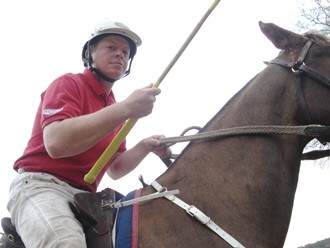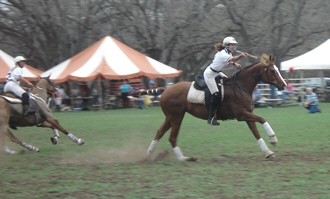| Rob “The Commodore” Shuttles is returning captain of the USA World Cup Polocrosse Team and the highest-rated player in America. Photos by Alexis Souza. |
Country cowboys. His eyes wide, he says, “I had no idea this was out here!”
Polocrosse, a sport that evolved out of Australia in the 1930s, is growing quickly in adrenaline-junkie horse-riding circles. In the 2000 Olympics in Sydney it was introduced as a trial event. It is a fusion of not only sport, but culture. Played on the backs of horses like the distinctively upperclass polo, but utilizing racquets similar to the more bruising game of lacrosse, it is a hybrid that appeals to equally diverse backgrounds. The Texas Hill country, as Willie Nelson so eloquently pointed out, is a melting pot for these sorts of amalgams (hippies & rednecks, remember?) so it’s appropriate that this area has become home base for the United States’ top Polocrosse players.
“We may be in Texas, but this area has a lot of rock stars,” comments Edmund Schenecker, manager of the USA World Cup Polocrosse Team, which heads to Australia this week to compete against seven other nations for the championship title. The best Polocrosse players in the United States are right here in our own backyard, says Schenecker, and many more have moved to the area to train and play, making Texas the largest concentration of Polocrosse players in the country. “That guy with the number one on his jersey, he is the national champion of Polocrosse and this will be the second time he has gone to the World Cup.”
Across the way, six players, three for each team, were lining up and the umpire had the nerf-like ball in his hand. “It is soft enough that if you get hit with it you won’t die, but it sure does sting,” laughs Schenecker, and with that we watched the umpire throw the ball into the lineup.
The field itself is about seven feet
narrower than a football field, but put six fast horses mimicking basketball players on offense and defense and it starts to feel much smaller. The play is fast and aggressive yet somehow graceful as the horses bob and weave around each other and the players sweep the ball off the ground and throw it to one another effortlessly, catching it in a small net at the end of a 36-inch long stick. Each chukka, or period of play, is only about eight minutes long (with four to six chukkas in a game) so I found that even the most attention-challenged observer doesn’t have time to get distracted. The rules of the game are simple enough that they are easily followed, but the movement of the riders and horses is truly the draw.
Polocrosse has been called the “King of the One-Horse Sports,” as the riders can only use one horse in the game. Unlike polo, in which many horses can be utilized, the one-horse rule opens up the game to people of any social class, not just those who can afford many ponies. Horses and riders alternate chukkas to allow for resting periods, and at the World Cup, all players will draw Australian horses selected for the tournament rather than their own mounts.
| Fast and furious play on a Hill Country Polocrosse field. |
Watching them race down the field kicking up the Texas dirt, I couldn’t help but think that the horses mimicked their cutting horse and barrel-racing counterparts at the cattle ranch next door, but with a special twist that makes them uniquely Polocrosse horses. Only one rider can score points, so teammates must throw the ball to that rider, called an attack player, who must bounce the ball within an 11-yard circumference of the goal, catch it, and then throw it in. All this with another rider working furiously to knock the ball out of the attack player’s racquet — not to mention the people in the stands yelling “Great wood, great wood.” (“Giving wood” is the term for the upward swing used to dislodge the ball; it is even more distracting when you don’t know what it means.)
Polocrosse is also unique in that, while skill levels may vary among players, it is a sport of equality that families, and people of almost any age, can play together. It may be fast and furious, but it is relatively safe and humane because the rules have been set up to protect the horses and the riders. Women and men play on equal levels. Children and their grandparents have been known to have a chukka or two.
Having said that, the top champions of this sport train very hard. The World Cup Team has been preparing for this year’s meet since their last trip four years ago. “We were scraping together a team back then, really in our beginning stages,” says Schenecker. Since the last World Cup Tournament in 2003, the U.S. team has put together development teams that work with the best American talent and continue to refine and grow the players. They sport team uniforms proudly and spend many an evening bonding over Mexican food, preparing to take on the international competition. They have a fun-loving, thrill- seeker vibe about them — until they take the field, and then it appears to be
business.
The game appeals to players with wildly divergent day jobs, from ranch hands and ropers awaiting the day Polocrosse pays like other sports to businesspeople that own professional football teams and enjoy the weekend thrill. The World Cup Team’s backgrounds are just as eclectic: an engineer, an airline attendant, a real-estate broker, a riding instructor, an artist, and more. The one consistency I found was their love for outdoor adventure and the adrenaline rush. Team Manager Schenecker, an art collector and business owner, said he came into the sport through friends. Renee Thompson, a flight attendant for Southwest Airlines headed to her second World Cup, says that what she loves about the sport is the people she meets from all over the world.
Not 20 minutes after “number-one player” Rob “The Commodore” Shuttles was flying downfield wielding a racquet over his head and throwing the ball through the uprights for a goal, I found him carrying his toddler on his horse, wandering peacefully beneath the Live Oaks that surround the field. Polocrosse appears to be a family-oriented sport. Many of the newest players come from the United States Pony Club, part of the largest junior equestrian clubs in the world, and World Cup Team family members are invariably involved in some aspect of Polocrosse.
The U.S. team finished fifth in the 2003 World Cup, and they drew in the top class for this round, which will pit them against Australia for their first match. Joining the American team is native Australian Joy Poole, who won the Australian National Polocrosse Titles nine times and serves on every major board associated with the sport. On April 11, the players will be heading to the Ridley Polocrosse World Cup, held at the Morgan park in Warwick on Queensland’s Southern Downs. They will face eight other countries on April 23. The Australian Stock Horse Society has recruited 200 of the country’s top horses for the tournament, making it the second-largest drive in Australia during peacetime.
Sponsorship of the sport is still in its infancy, and the U.S. Team raised the money for the Australia roundtrip. Compared to the roughly 40 spectators that accompanied me in the stands outside Kerrville on the day I met this team, the 40,000 people expected to pack Morgan Park will be a taste of what is to come and the corporate sponsorships that will likely follow. But for now, it is still a pure sport that has a very pure heart.
The next opportunity to see the U.S. team in action will be at the Alamo Polocrosse Spring Tournament in Castroville, May 26-27. Contact Lindsay Ward at (210) 632-6119 for more information.



